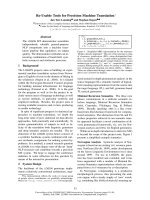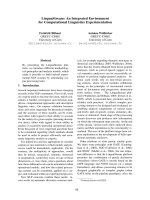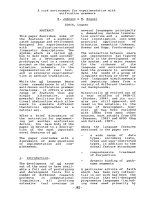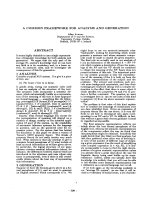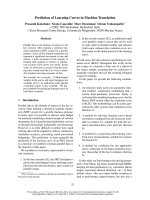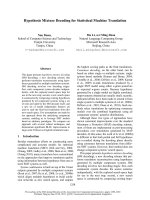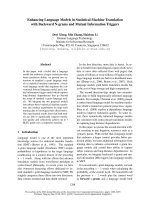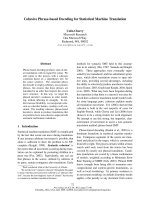Báo cáo khoa học: "Cohesive Phrase-based Decoding for Statistical Machine Translation" pot
Bạn đang xem bản rút gọn của tài liệu. Xem và tải ngay bản đầy đủ của tài liệu tại đây (202.34 KB, 9 trang )
Proceedings of ACL-08: HLT, pages 72–80,
Columbus, Ohio, USA, June 2008.
c
2008 Association for Computational Linguistics
Cohesive Phrase-based Decoding for Statistical Machine Translation
Colin Cherry
∗
Microsoft Research
One Microsoft Way
Redmond, WA, 98052
Abstract
Phrase-based decoding produces state-of-the-
art translations with no regard for syntax. We
add syntax to this process with a cohesion
constraint based on a dependency tree for
the source sentence. The constraint allows
the decoder to employ arbitrary, non-syntactic
phrases, but ensures that those phrases are
translated in an order that respects the source
tree’s structure. In this way, we target the
phrasal decoder’s weakness in order model-
ing, without affecting its strengths. To fur-
ther increase flexibility, we incorporate cohe-
sion as a decoder feature, creating a soft con-
straint. The resulting cohesive, phrase-based
decoder is shown to produce translations that
are preferred over non-cohesive output in both
automatic and human evaluations.
1 Introduction
Statistical machine translation (SMT) is complicated
by the fact that words can move during translation.
If one assumes arbitrary movement is possible, that
alone is sufficient to show the problem to be NP-
complete (Knight, 1999). Syntactic cohesion
1
is
the notion that all movement occurring during trans-
lation can be explained by permuting children in a
parse tree (Fox, 2002). Equivalently, one can say
that phrases in the source, defined by subtrees in
its parse, remain contiguous after translation. Early
∗
Work conducted while at the University of Alberta.
1
We use the term “syntactic cohesion” throughout this paper
to mean what has previously been referred to as “phrasal cohe-
sion”, because the non-linguistic sense of “phrase” has become
so common in machine translation literature.
methods for syntactic SMT held to this assump-
tion in its entirety (Wu, 1997; Yamada and Knight,
2001). These approaches were eventually super-
seded by tree transducers and tree substitution gram-
mars, which allow translation events to span sub-
tree units, providing several advantages, including
the ability to selectively produce uncohesive transla-
tions (Eisner, 2003; Graehl and Knight, 2004; Quirk
et al., 2005). What may have been forgotten during
this transition is that there is a reason it was once be-
lieved that a cohesive translation model would work:
for some language pairs, cohesion explains nearly
all translation movement. Fox (2002) showed that
cohesion is held in the vast majority of cases for
English-French, while Cherry and Lin (2006) have
shown it to be a strong feature for word alignment.
We attempt to use this strong, but imperfect, char-
acterization of movement to assist a non-syntactic
translation method: phrase-based SMT.
Phrase-based decoding (Koehn et al., 2003) is a
dominant formalism in statistical machine transla-
tion. Contiguous segments of the source are trans-
lated and placed in the target, which is constructed
from left to right. The process iterates within a beam
search until each word from the source has been
covered by exactly one phrasal translation. Candi-
date translations are scored by a linear combination
of models, weighted according to Minimum Error
Rate Training or MERT (Och, 2003). Phrasal SMT
draws strength from being able to memorize non-
compositional and context-specific translations, as
well as local reorderings. Its primary weakness is
in movement modeling; its default distortion model
applies a flat penalty to any deviation from source
72
order, forcing the decoder to rely heavily on its lan-
guage model. Recently, a number of data-driven dis-
tortion models, based on lexical features and relative
distance, have been proposed to compensate for this
weakness (Tillman, 2004; Koehn et al., 2005; Al-
Onaizan and Papineni, 2006; Kuhn et al., 2006).
There have been a number of proposals to in-
corporate syntactic information into phrasal decod-
ing. Early experiments with syntactically-informed
phrases (Koehn et al., 2003), and syntactic re-
ranking of K-best lists (Och et al., 2004) produced
mostly negative results. The most successful at-
tempts at syntax-enhanced phrasal SMT have di-
rectly targeted movement modeling: Zens et al.
(2004) modified a phrasal decoder with ITG con-
straints, while a number of researchers have em-
ployed syntax-driven source reordering before de-
coding begins (Xia and McCord, 2004; Collins et
al., 2005; Wang et al., 2007).
2
We attempt some-
thing between these two approaches: our constraint
is derived from a linguistic parse tree, but it is used
inside the decoder, not as a preprocessing step.
We begin in Section 2 by defining syntactic cohe-
sion so it can be applied to phrasal decoder output.
Section 3 describes how to add both hard and soft
cohesion constraints to a phrasal decoder. Section 4
provides our results from both automatic and human
evaluations. Sections 5 and 6 provide a qualitative
discussion of cohesive output and conclude.
2 Cohesive Phrasal Output
Previous approaches to measuring the cohesion of
a sentence pair have worked with a word align-
ment (Fox, 2002; Lin and Cherry, 2003). This align-
ment is used to project the spans of subtrees from
the source tree onto the target sentence. If a modifier
and its head, or two modifiers of the same head, have
overlapping spans in the projection, then this indi-
cates a cohesion violation. To check phrasal trans-
lations for cohesion violations, we need a way to
project the source tree onto the decoder’s output.
Fortunately, each phrase used to create the target
sentence can be tracked back to its original source
phrase, providing an alignment between source and
2
While certainly both syntactic and successful, we consider
Hiero (Chiang, 2007) to be a distinct approach, and not an ex-
tension to phrasal decoding’s left-to-right beam search.
target phrases. Since each source token is used ex-
actly once during translation, we can transform this
phrasal alignment into a word-to-phrase alignment,
where each source token is linked to a target phrase.
We can then project the source subtree spans onto
the target phrase sequence. Note that we never con-
sider individual tokens on the target side, as their
connection to the source tree is obscured by the
phrasal abstraction that occurred during translation.
Let e
m
1
be the input source sentence, and
¯
f
p
1
be the
output target phrase sequence. Our word-to-phrase
alignment a
i
∈ [1, p], 1 ≤ i ≤ m, maps a source
token position i to a target phrase position a
i
. Next,
we introduce our source dependency tree T . Each
source token e
i
is also a node in T . We define T (e
i
)
to be the subtree of T rooted at e
i
. We define a local
tree to be a head node and its immediate modifiers.
With this notation in place, we can define our pro-
jected spans. Following Lin and Cherry (2003), we
define a head span to be the projection of a single
token e
i
onto the target phrase sequence:
spanH (e
i
, T, a
m
1
) = [a
i
, a
i
]
and the subtree span to be the projection of the sub-
tree rooted at e
i
:
spanS(e
i
, T, a
m
1
) =
min
{j|e
j
∈T (e
i
)}
a
j
, max
{k|e
k
∈T (e
i
)}
a
k
Consider the simple phrasal translation shown in
Figure 1 along with a dependency tree for the En-
glish source. If we examine the local tree rooted at
likes, we get the following projected spans:
spanS(nobody, T, a) = [1, 1]
spanH (likes, T, a) = [1, 1]
spanS(pay, T, a) = [1, 2]
For any local tree, we consider only the head span of
the head, and the subtree spans of any modifiers.
Typically, cohesion would be determined by
checking these projected spans for intersection.
However, at this level of resolution, avoiding inter-
section becomes highly restrictive. The monotone
translation in Figure 1 would become non-cohesive:
nobody intersects with both its sibling pay and with
its head likes at phrase index 1. This complica-
tion stems from the use of multi-word phrases that
73
nobody likes to pay taxes
personne n ' aime payer des impôts
(nobody likes)
(paying taxes)
1
2
Figure 1: An English source tree with translated French
output. Segments are indicated with underlined spans.
do not correspond to syntactic constituents. Re-
stricting phrases to syntactic constituents has been
shown to harm performance (Koehn et al., 2003), so
we tighten our definition of a violation to disregard
cases where the only point of overlap is obscured by
our phrasal resolution. To do so, we replace span
intersection with a new notion of span innersection.
Assume we have two spans [u, v] and [x, y] that
have been sorted so that [u, v] ≤ [x, y] lexicograph-
ically. We say that the two spans innersect if and
only if x < v. So, [1, 3] and [2, 4] innersect, while
[1, 3] and [3, 4] do not. One can think of innersection
as intersection, minus the cases where the two spans
share only a single boundary point, where x = v.
When two projected spans innersect, it indicates that
the second syntactic constituent must begin before
the first ends. If the two spans in question corre-
spond to nodes in the same local tree, innersection
indicates an unambiguous cohesion violation. Un-
der this definition, the translation in Figure 1 is co-
hesive, as none of its spans innersect.
Our hope is that syntactic cohesion will help the
decoder make smarter distortion decisions. An ex-
ample with distortion is shown in Figure 2. In this
case, we present two candidate French translations
of an English sentence, assuming there is no entry
in the phrase table for “voting session.” Because the
proper French construction is “session of voting”,
the decoder has to move voting after session using a
distortion operation. Figure 2 shows two methods to
do so, each using an equal numbers of phrases. The
projected spans for the local tree rooted at begins
in each candidate are shown in Table 1. Note the
innersection between the head begins and its modi-
fier session in (b). Thus, a cohesion-aware system
would receive extra guidance to select (a), which
maintains the original meaning much better than (b).
Span (a) (b)
spanS(session, T, a) [1,3] [1,3]*
spanH (begins, T, a) [4,4] [2,2]*
spanS(tomorrow, T, a) [4,4] [4,4]
Table 1: Spans of the local trees rooted at begins from
Figures 2 (a) and (b). Innersection is marked with a “*”.
2.1 K-best List Filtering
A first attempt at using cohesion to improve SMT
output would be to apply our definition as a filter on
K-best lists. That is, we could have a phrasal de-
coder output a 1000-best list, and return the highest-
ranked cohesive translation to the user. We tested
this approach on our English-French development
set, and saw no improvement in BLEU score. Er-
ror analysis revealed that only one third of the un-
cohesive translations had a cohesive alternative in
their 1000-best lists. In order to reach the remain-
ing two thirds, we need to constrain the decoder’s
search space to explore only cohesive translations.
3 Cohesive Decoding
This section describes a modification to standard
phrase-based decoding, so that the system is con-
strained to produce only cohesive output. This will
take the form of a check performed each time a hy-
pothesis is extended, similar to the ITG constraint
for phrasal SMT (Zens et al., 2004). To create a
such a check, we need to detect a cohesion viola-
tion inside a partial translation hypothesis. We can-
not directly apply our span-based cohesion defini-
tion, because our word-to-phrase alignment is not
yet complete. However, we can still detect viola-
tions, and we can do so before the spans involved
are completely translated.
Recall that when two projected spans a and b
(a < b) innersect, it indicates that b begins before a
ends. We can say that the translation of b interrupts
the translation of a. We can enforce cohesion by en-
suring that these interruptions never happen. Be-
cause the decoder builds its translations from left to
right, eliminating interruptions amounts to enforcing
the following rule: once the decoder begins translat-
ing any part of a source subtree, it must cover all
74
the voting session begins tomorrow
la session de vote débute demain
2 3 4
1
(the) (session) (of voting) (begins tomorrow)
(a) (b)
1 2
the voting session begins tomorrow
3
4
la session commence à voter demain
(the) (session begins) (to vote) (tomorrow)
2
Figure 2: Two candidate translations for the same parsed source. (a) is cohesive, while (b) is not.
the words under that subtree before it can translate
anything outside of it.
For example, in Figure 2b, the decoder translates
the, which is part of T(session) in
¯
f
1
. In
¯
f
2
, it trans-
lates begins, which is outside T(session). Since we
have yet to cover voting, we know that the projected
span of T (session) will end at some index v > 2,
creating an innersection. This eliminates the hypoth-
esis after having proposed only the first two phrases.
3.1 Algorithm
In this section, we formally define an interruption,
and present an algorithm to detect one during de-
coding. During both discussions, we represent each
target phrase as a set that contains the English tokens
used in its translation:
¯
f
j
= {e
i
|a
i
= j}. Formally,
an interruption occurs whenever the decoder would
add a phrase
¯
f
h+1
to the hypothesis
¯
f
h
1
, and:
∃r ∈ T such that:
∃e ∈ T (r) s.t. e ∈
¯
f
h
1
(a. Started)
∃e
/∈ T (r) s.t. e
∈
¯
f
h+1
(b. Interrupted)
∃e
∈ T (r) s.t. e
/∈
¯
f
h+1
1
(c. Unfinished)
(1)
The key to checking for interruptions quickly is
knowing which subtrees T (r) to check for qualities
(1:a,b,c). A na
¨
ıve approach would check every sub-
tree that has begun translation in
¯
f
h
1
. Figure 3a high-
lights the roots of all such subtrees for a hypothetical
T and
¯
f
h
1
. Fortunately, with a little analysis that ac-
counts for
¯
f
h+1
, we can show that at most two sub-
trees need to be checked.
For a given interruption-free
¯
f
h
1
, we call subtrees
that have begun translation, but are not yet complete,
open subtrees. Only open subtrees can lead to inter-
ruptions. We can focus our interruption check on
¯
f
h
, the last phrase in
¯
f
h
1
, as any open subtree T (r)
must contain at least one e ∈
¯
f
h
. If this were not the
Algorithm 1 Interruption check.
• Get the left and right-most tokens used to create
¯
f
h
, call them e
L
and e
R
• For each of e ∈ {e
L
, e
R
}:
i. r
← e, r ← null
While ∃e
∈
¯
f
h+1
such that e
/∈ T (r
):
r ← r
, r
← parent(r)
ii. If r = null and ∃e
∈ T (r) such that
e
/∈
¯
f
h+1
1
, then
¯
f
h+1
interrupts T(r).
case, then the open T (r) must have began translation
somewhere in
¯
f
h−1
1
, and T (r) would be interrupted
by the placement of
¯
f
h
. Since our hypothesis
¯
f
h
1
is interruption-free, this is impossible. This leaves
the subtrees highlighted in Figure 3b to be checked.
Furthermore, we need only consider subtrees that
contain the left and right-most source tokens e
L
and
e
R
translated by
¯
f
h
. Since
¯
f
h
was created from a
contiguous string of source tokens, any distinct sub-
tree between these two endpoints will be completed
within
¯
f
h
. Finally, for each of these focus points
e
L
and e
R
, only the highest containing subtree T (r)
that does not completely contain
¯
f
h+1
needs to be
considered. Anything higher would contain all of
¯
f
h+1
, and would not satisfy requirement (1:b) of our
interruption definition. Any lower subtree would be
a descendant of r, and therefore the check for the
lower subtree is subsumed by the check for T (r).
This leaves only two subtrees, highlighted in our
running example in Figure 3c.
With this analysis in place, an extension
¯
f
h+1
of
the hypothesis
¯
f
h
1
can be checked for interruptions
with Algorithm 1. Step (i) in this algorithm finds
an ancestor r
such that T (r
) completely contains
75
f h
f h+1
f
h
1
f h
f h+1
f
h
1
f h
f h+1
f
h
1
a)
b)
c)
Figure 3: Narrowing down the source subtrees to be checked for completeness.
¯
f
h+1
, and then returns r, the highest node that does
not contain
¯
f
h+1
. We know this r satisfies require-
ments (1:a,b). If there is no T (r) that does not con-
tain
¯
f
h+1
, then e and its ancestors cannot lead to an
interruption. Step (ii) then checks the coverage vec-
tor of the hypothesis
3
to make sure that T (r) is cov-
ered in
¯
f
h+1
1
. If T (r) is not complete in
¯
f
h+1
1
, then
that satisfies requirement (1:c), which means an in-
terruption has occurred.
For example, in Figure 2b, our first interruption
occurs as we add
¯
f
h+1
=
¯
f
2
to
¯
f
h
1
=
¯
f
1
1
. The de-
tection algorithm would first get the left and right
boundaries of
¯
f
1
; in this case, the is both e
L
and
e
R
. Then, it would climb up the tree from the until
it reached r
= begins and r = session. It would
then check T (session) for coverage in
¯
f
2
1
. Since
voting ∈ T (session) is not covered in
¯
f
2
1
, it would
detect an interruption.
Walking up the tree takes at most linear time,
and each check to see if T (r) contains all of
¯
f
h+1
can be performed in constant time, provided the
source spans of each subtree have been precom-
puted. Checking to see if all of T (r) has been cov-
ered in Step (ii) takes at most linear time. This
makes the entire process linear in the size of the
source sentence.
3.2 Soft Constraint
Syntactic cohesion is not a perfect constraint for
translation. Parse errors and systematic violations
can create cases where cohesion works against the
decoder. Fox (2002) demonstrated and counted
cases where cohesion was not maintained in hand-
aligned sentence-pairs, while Cherry and Lin (2006)
3
This coverage vector is maintained by all phrasal decoders
to track how much of the source sentence has been covered by
the current partial translation, and to ensure that the same token
is not translated twice.
showed that a soft cohesion constraint is superior to
a hard constraint for word alignment. Therefore, we
propose a soft version of our cohesion constraint.
We perform our interruption check, but we do not
invalidate any hypotheses. Instead, each hypothe-
sis maintains a count of the number of extensions
that have caused interruptions during its construc-
tion. This count becomes a feature in the decoder’s
log-linear model, the weight of which is trained with
MERT. After the first interruption, the exact mean-
ing of further interruptions becomes difficult to in-
terpret; but the interruption count does provide a
useful estimate of the extent to which the translation
is faithful to the source tree structure.
Initially, we were not certain to what extent this
feature would be used by the MERT module, as
BLEU is not always sensitive to syntactic improve-
ments. However, trained with our French-English
tuning set, the interruption count received the largest
absolute feature weight, indicating, at the very least,
that the feature is worth scaling to impact decoder.
3.3 Implementation
We modify the Moses decoder (Koehn et al., 2007)
to translate head-annotated sentences. The decoder
stores the flat sentence in the original sentence data
structure, and the head-encoded dependency tree in
an attached tree data structure. The tree structure
caches the source spans corresponding to each of
its subtrees. We then implement both a hard check
for interruptions to be used before hypotheses are
placed on the stack,
4
and a soft check that is used to
calculate an interruption count feature.
4
A hard cohesion constraint used in conjunction with a tra-
ditional distortion limit also requires a second linear-time check
to ensure that all subtrees currently in progress can be finished
under the constraints induced by the distortion limit.
76
Set Cohesive Uncohesive
Dev-Test 1170 330
Test 1563 437
Table 2: Number of sentences that receive cohesive trans-
lations from the baseline decoder. This property also de-
fines our evaluation subsets.
4 Experiments
We have adapted the notion of syntactic cohesion so
that it is applicable to phrase-based decoding. This
results in a translation process that respects source-
side syntactic boundaries when distorting phrases.
In this section we will test the impact of such infor-
mation on an English to French translation task.
4.1 Experimental Details
We test our cohesion-enhanced Moses decoder
trained using 688K sentence pairs of Europarl
French-English data, provided by the SMT 2006
Shared Task (Koehn and Monz, 2006). Word align-
ments are provided by GIZA++ (Och and Ney,
2003) with grow-diag-final combination, with in-
frastructure for alignment combination and phrase
extraction provided by the shared task. We decode
with Moses, using a stack size of 100, a beam thresh-
old of 0.03 and a distortion limit of 4. Weights for
the log-linear model are set using MERT, as imple-
mented by Venugopal and Vogel (2005). Our tuning
set is the first 500 sentences of the SMT06 develop-
ment data. We hold out the remaining 1500 develop-
ment sentences for development testing (dev-test),
and the entirety of the provided 2000-sentence test
set for blind testing (test). Since we require source
dependency trees, all experiments test English to
French translation. English dependency trees are
provided by Minipar (Lin, 1994).
Our cohesion constraint directly targets sentences
for which an unmodified phrasal decoder produces
uncohesive output according to the definition in Sec-
tion 2. Therefore, we present our results not only on
each test set in its entirety, but also on the subsets
defined by whether or not the baseline naturally pro-
duces a cohesive translation. The sizes of the result-
ing evaluation sets are given in Table 2.
Our development tests indicated that the soft and
hard cohesion constraints performed somewhat sim-
ilarly, with the soft constraint providing more sta-
ble, and generally better results. We confirmed these
trends on our test set, but to conserve space, we pro-
vide detailed results for only the soft constraint.
4.2 Automatic Evaluation
We first present our soft cohesion constraint’s ef-
fect on BLEU score (Papineni et al., 2002) for both
our dev-test and test sets. We compare against an
unmodified baseline decoder, as well as a decoder
enhanced with a lexical reordering model (Tillman,
2004; Koehn et al., 2005). For each phrase pair in
our translation table, the lexical reordering model
tracks statistics on its reordering behavior as ob-
served in our word-aligned training text. The lex-
ical reordering model provides a good comparison
point as a non-syntactic, and potentially orthogonal,
improvement to phrase-based movement modeling.
We use the implementation provided in Moses, with
probabilities conditioned on bilingual phrases and
predicting three orientation bins: straight, inverted
and disjoint. Since adding features to the decoder’s
log-linear model is straight-forward, we also experi-
ment with a combined system that uses both the co-
hesion constraint and a lexical reordering model.
The results of our experiments are shown in Ta-
ble 3, and reveal some interesting phenomena. First
of all, looking across columns, we can see that there
is a definite divide in BLEU score between our two
evaluation subsets. Sentences with cohesive base-
line translations receive much higher BLEU scores
than those with uncohesive baseline translations.
This indicates that the cohesive subset is easier to
translate with a phrase-based system. Our definition
of cohesive phrasal output appears to provide a use-
ful feature for estimating translation confidence.
Comparing the baseline with and without the soft
cohesion constraint, we see that cohesion has only a
modest effect on BLEU, when measured on all sen-
tence pairs, with improvements ranging between 0.2
and 0.5 absolute points. Recall that the majority of
baseline translations are naturally cohesive. The co-
hesion constraint’s effect is much more pronounced
on the more difficult uncohesive subsets, showing
absolute improvements between 0.5 and 1.1 points.
Considering the lexical reordering model, we see
that its effect is very similar to that of syntactic co-
hesion. Its BLEU scores are very similar, with lex-
77
Dev-Test Test
System All Cohesive Uncohesive All Cohesive Uncohesive
base 32.04 33.80 27.46 32.35 33.78 28.73
lex 32.19 33.91 27.86 32.71 33.89 29.66
coh 32.22 33.82 28.04 32.88 34.03 29.86
lex+coh
32.45 34.12 28.09 32.90 34.04 29.83
Table 3: BLEU scores with an integrated soft cohesion constraint (coh) or a lexical reordering model (lex). Any system
significantly better than base has been highlighted, as tested by bootstrap re-sampling with a 95% confidence interval.
ical reordering also affecting primarily the uncohe-
sive subset. This similarity in behavior is interesting,
as its data-driven, bilingual reordering probabilities
are quite different from our cohesion flag, which is
driven by monolingual syntax.
Examining the system that employs both move-
ment models, we see that the combination (lex+coh)
receives the highest score on the dev-test set. A large
portion of the combined system’s gain is on the co-
hesive subset, indicating that the cohesion constraint
may be enabling better use of the lexical reordering
model on otherwise cohesive translations. Unfor-
tunately, these same gains are not born out on the
test set, where the lexical reordering model appears
unable to improve upon the already strong perfor-
mance of the cohesion constraint.
4.3 Human Evaluation
We also present a human evaluation designed to de-
termine whether bilingual speakers prefer cohesive
decoder output. Our comparison systems are the
baseline decoder (base) and our soft cohesion con-
straint (coh). We evaluate on our dev-test set,
5
as it
has our smallest observed BLEU-score gap, and we
wish to determine if it is actually improving. Our ex-
perimental set-up is modeled after the human evalu-
ation presented in (Collins et al., 2005). We provide
two human annotators
6
a set of 75 English source
sentences, along with a reference translation and a
pair of translation candidates, one from each sys-
tem. The annotators are asked to indicate which of
the two system translations they prefer, or if they
5
The cohesion constraint has no free parameters to optimize
during development, so this does not create an advantage.
6
Annotators were both native English speakers who speak
French as a second language. Each has a strong comprehension
of written French.
Annotator #2
Annotator #1 base coh equal sum (#1)
base 6 7 1 14
coh 8 35 4 47
equal 7 4 3 14
sum (#2) 21 46 8
Table 4: Confusion matrix from human evaluation.
consider them to be equal. To avoid bias, the com-
peting systems were presented anonymously and in
random order. Following (Collins et al., 2005), we
provide the annotators with only short sentences:
those with source sentences between 10 and 25 to-
kens long. Following (Callison-Burch et al., 2006),
we conduct a targeted evaluation; we only draw our
evaluation pairs from the uncohesive subset targeted
by our constraint. All 75 sentences that meet these
two criteria are included in the evaluation.
The aggregate results of our human evaluation are
shown in the bottom row and right-most column of
Table 4. Each annotator prefers coh in over 60% of
the test sentences, and each prefers base in less than
30% of the test sentences. This presents strong evi-
dence that we are having a consistent, positive effect
on formerly non-cohesive translations. A complete
confusion matrix indicating agreement between the
two annotators is also given in Table 4. There are a
few more off-diagonal points than one might expect,
but it is clear that the two annotators are in agree-
ment with respect to coh’s improvements. A com-
bination annotator, which selects base or coh only
when both human annotators agree and equal oth-
erwise, finds base is preferred in only 8% of cases,
compared to 47% for coh.
78
(1+) creating structures that do not currently exist and reducing . . .
base de cr
´
eer des structures qui existent actuellement et ne pas r
´
eduire . . .
to create structures that actually exist and do not reduce . . .
coh de cr
´
eer des structures qui n ’ existent pas encore et r
´
eduire . . .
to create structures that do not yet exist and reduce . . .
(2−) . . . repealed the 1998 directive banning advertising
base . . . abrog
´
ee l’interdiction de la directive de 1998 de publicit
´
e
. . . repealed the ban from the 1998 directive on advertising
coh . . . abrog
´
ee la directive de 1998 l’interdiction de publicit
´
e
. . . repealed the 1998 directive the ban on advertising
Table 5: A comparison of baseline and cohesion-constrained English-to-French translations, with English glosses.
5 Discussion
Examining the French translations produced by our
cohesion constrained phrasal decoder, we can draw
some qualitative generalizations. The constraint is
used primarily to prevent distortion: it provides an
intelligent estimate as to when source order must be
respected. The resulting translations tend to be more
literal than unconstrained translations. So long as
the vocabulary present in our phrase table and lan-
guage model supports a literal translation, cohesion
tends to produce an improvement. Consider the first
translation example shown in Table 5. In the base-
line translation, the language model encourages the
system to move the negation away from “exist” and
toward “reduce.” The result is a tragic reversal of
meaning in the translation. Our cohesion constraint
removes this option, forcing the decoder to assem-
ble the correct French construction for “does not yet
exist.” The second example shows a case where our
resources do not support a literal translation. In this
case, we do not have a strong translation mapping to
produce a French modifier equivalent to the English
“banning.” Stuck with a noun form (“the ban”), the
baseline is able to distort the sentence into some-
thing that is almost correct (the above gloss is quite
generous). The cohesive system, even with a soft
constraint, cannot reproduce the same movement,
and returns a less grammatical translation.
We also examined cases where the decoder over-
rides the soft cohesion constraint and produces an
uncohesive translation. We found this was done very
rarely, and primarily to overcome parse errors. Only
one correct syntactic construct repeatedly forced the
decoder to override cohesion: Minipar’s conjunction
representation, which connects conjuncts in parent-
child relationships, is at times too restrictive. A sib-
ling representation, which would allow conjuncts to
be permuted arbitrarily, may work better.
6 Conclusion
We have presented a definition of syntactic cohesion
that is applicable to phrase-based SMT. We have
used this definition to develop a linear-time algo-
rithm to detect cohesion violations in partial decoder
hypotheses. This algorithm was used to implement
a soft cohesion constraint for the Moses decoder,
based on a source-side dependency tree.
Our experiments have shown that roughly 1/5 of
our baseline English-French translations contain co-
hesion violations, and these translations tend to re-
ceive lower BLEU scores. This suggests that co-
hesion could be a strong feature in estimating the
confidence of phrase-based translations. Our soft
constraint produced improvements ranging between
0.5 and 1.1 BLEU points on sentences for which the
baseline produces uncohesive translations. A human
evaluation showed that translations created using a
soft cohesion constraint are preferred over uncohe-
sive translations in the majority of cases.
Acknowledgments Special thanks to Dekang Lin,
Shane Bergsma, and Jess Enright for their useful
insights and discussions, and to the anonymous re-
viewers for their comments. The author was funded
by Alberta Ingenuity and iCORE studentships.
79
References
Y. Al-Onaizan and K. Papineni. 2006. Distortion models
for statistical machine translation. In COLING-ACL,
pages 529–536, Sydney, Australia.
C. Callison-Burch, M. Osborne, and P. Koehn. 2006. Re-
evaluating the role of BLEU in machine translation re-
search. In EACL, pages 249–256.
C. Cherry and D. Lin. 2006. Soft syntactic constraints
for word alignment through discriminative training. In
COLING-ACL, Sydney, Australia, July. Poster.
D. Chiang. 2007. Hierarchical phrase-based translation.
Computational Linguistics, 33(2):201–228, June.
M. Collins, P. Koehn, and I. Kucerova. 2005. Clause re-
structuring for statistical machine translation. In ACL,
pages 531–540.
J. Eisner. 2003. Learning non-ismorphic tree mappings
for machine translation. In ACL, Sapporo, Japan.
Short paper.
H. J. Fox. 2002. Phrasal cohesion and statistical machine
translation. In EMNLP, pages 304–311.
J. Graehl and K. Knight. 2004. Training tree transducers.
In HLT-NAACL, pages 105–112, Boston, USA, May.
K. Knight. 1999. Squibs and discussions: Decod-
ing complexity in word-replacement translation mod-
els. Computational Linguistics, 25(4):607–615, De-
cember.
P. Koehn and C. Monz. 2006. Manual and automatic
evaluation of machine translation. In HLT-NACCL
Workshop on Statistical Machine Translation, pages
102–121.
P. Koehn, F. J. Och, and D. Marcu. 2003. Statistical
phrase-based translation. In HLT-NAACL, pages 127–
133.
P. Koehn, A. Axelrod, A. Birch Mayne, C. Callison-
Burch, M. Osborne, and David Talbot. 2005. Edin-
burgh system description for the 2005 IWSLT speech
translation evaluation. In International Workshop on
Spoken Language Translation.
P. Koehn, H. Hoang, A. Birch, C. Callison-Burch,
M. Federico, N. Bertoldi, B. Cowan, W. Shen,
C. Moran, R. Zens, C. Dyer, O. Bojar, A. Constantin,
and E. Herbst. 2007. Moses: Open source toolkit for
statistical machine translation. In ACL. Demonstra-
tion.
R. Kuhn, D. Yuen, M. Simard, P. Paul, G. Foster, E. Joa-
nis, and H. Johnson. 2006. Segment choice models:
Feature-rich models for global distortion in statistical
machine translation. In HLT-NAACL, pages 25–32,
New York, NY.
D. Lin and C. Cherry. 2003. Word alignment with co-
hesion constraint. In HLT-NAACL, pages 49–51, Ed-
monton, Canada, May. Short paper.
D. Lin. 1994. Principar - an efficient, broad-coverage,
principle-based parser. In COLING, pages 42–48, Ky-
oto, Japan.
F. J. Och and H. Ney. 2003. A systematic comparison of
various statistical alignment models. Computational
Linguistics, 29(1):19–52.
F. J. Och, D. Gildea, S. Khudanpur, A. Sarkar, K. Ya-
mada, A. Fraser, S. Kumar, L. Shen, D. Smith, K. Eng,
V. Jain, Z. Jin, and D. Radev. 2004. A smorgasbord
of features for statistical machine translation. In HLT-
NAACL 2004: Main Proceedings, pages 161–168.
F. J. Och. 2003. Minimum error rate training for statisti-
cal machine translation. In ACL, pages 160–167.
K. Papineni, S. Roukos, T. Ward, and W. J. Zhu. 2002.
BLEU: a method for automatic evaluation of machine
translation. In ACL, pages 311–318.
C. Quirk, A. Menezes, and C. Cherry. 2005. De-
pendency treelet translation: Syntactically informed
phrasal SMT. In ACL, pages 271–279, Ann Arbor,
USA, June.
C. Tillman. 2004. A unigram orientation model for sta-
tistical machine translation. In HLT-NAACL, pages
101–104. Short paper.
A. Venugopal and S. Vogel. 2005. Considerations in
maximum mutual information and minimum classifi-
cation error training for statistical machine translation.
In EAMT.
C. Wang, M. Collins, and P. Koehn. 2007. Chinese syn-
tactic reordering for statistical machine translation. In
EMNLP, pages 737–745.
D. Wu. 1997. Stochastic inversion transduction gram-
mars and bilingual parsing of parallel corpora. Com-
putational Linguistics, 23(3):377–403.
F. Xia and M. McCord. 2004. Improving a statistical mt
system with automatically learned rewrite patterns. In
Proceedings of Coling 2004, pages 508–514.
K. Yamada and K. Knight. 2001. A syntax-based statis-
tical translation model. In ACL, pages 523–530.
R. Zens, H. Ney, T. Watanabe, and E. Sumita. 2004.
Reordering constraints for phrase-based statistical ma-
chine translation. In COLING, pages 205–211,
Geneva, Switzerland, August.
80

